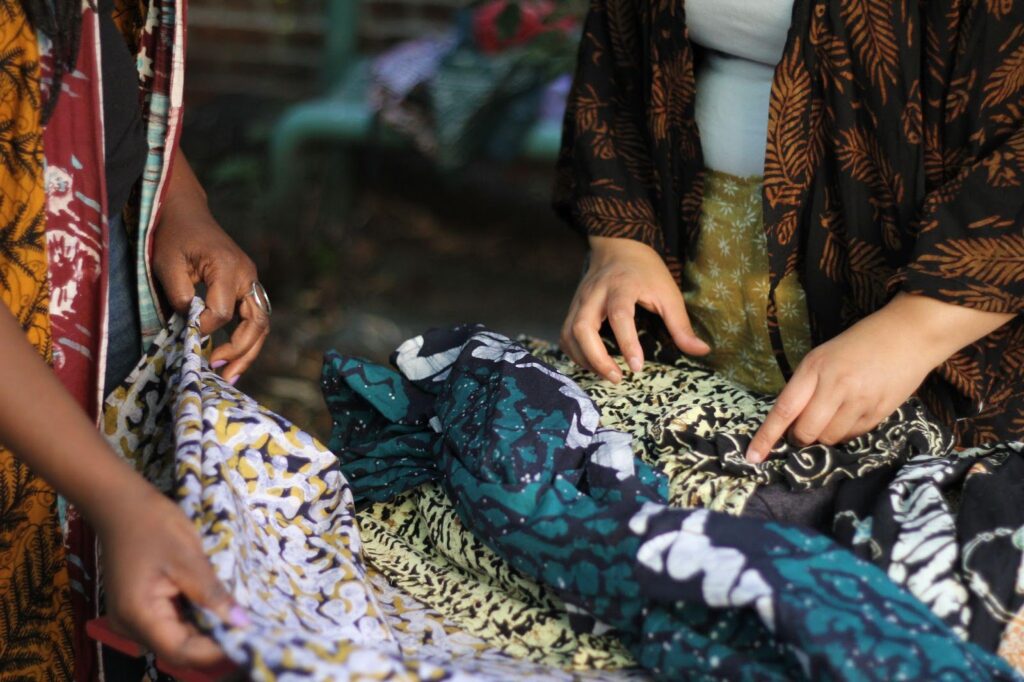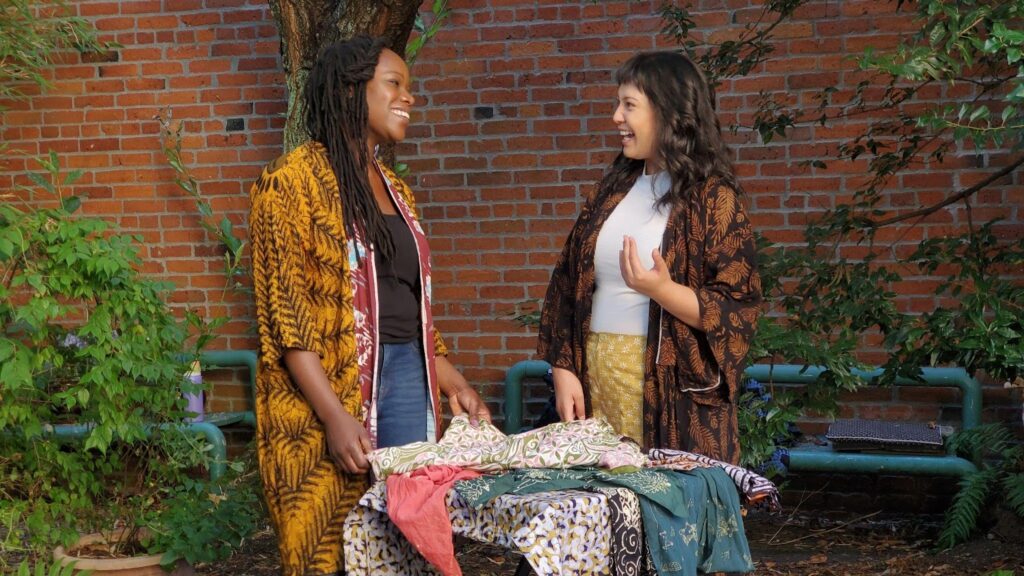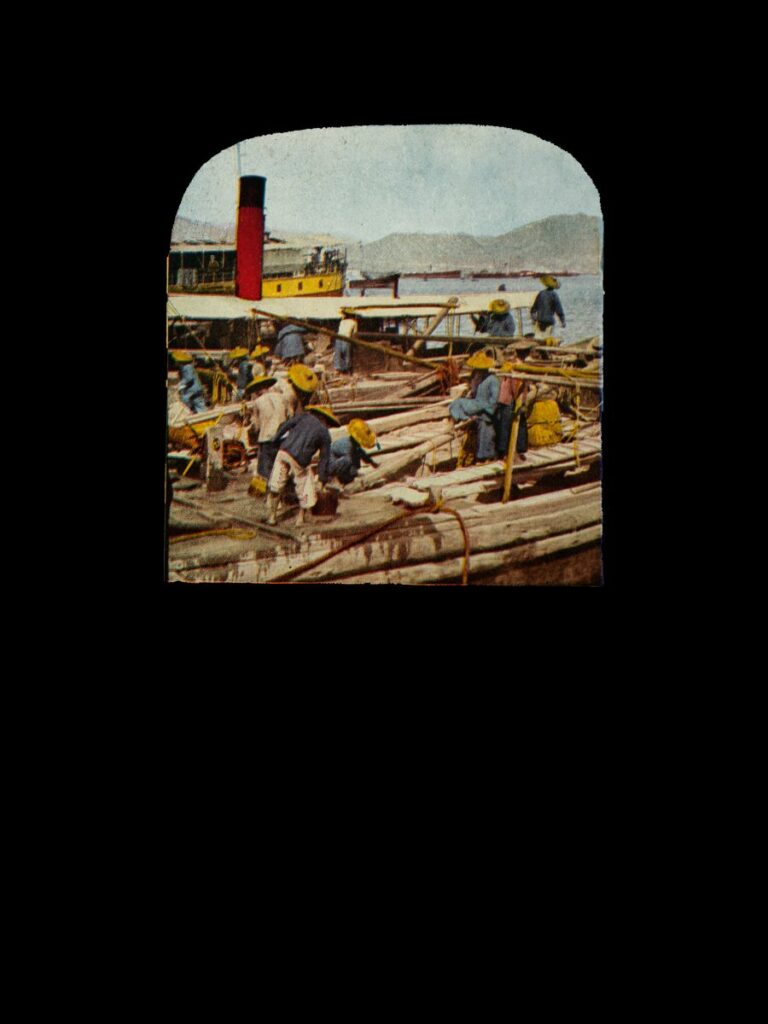The art of ancestral listening through batik

November 30, 2023
As artists who are guided by batik—a wax-resistant dyeing technique—Stephanie Ameyaw and Romila Barryman are dedicated to following ancestral clues in these intricately patterned fabrics. Originating from the island of Java, the art of batik traveled and was traded through Asia and Africa. Each region has developed distinct motifs and patterns based on its own histories and environment.
In their research of this ancient art form, Ameyaw and Barryman have come across the same colonial thesis: Javanese batik was introduced to African countries, including Ghana, as a result of Dutch imperialism. The two friends, however, believe this narrative is unreliable and instead seek to listen to their ancestors through the fabric to intuit how batik spread between their cultures. If we can acknowledge the way “history has been colonially arranged and curated,” as Romila notes, then perhaps the work is in “listening to the gaps.”
Shaped by curiosity and learning in togetherness, Stephanie and Romila’s relationship was catalyzed through the Community Capacity Building Certificate issued by Simon Fraser University. This Indigenous and Black–led container to explore and deepen their connection to community revealed a shared journey with batik that affirmed what they already knew: they meet today because their ancestors knew of each other in the so-called past, speaking through the fabric that was passed down, gifted and accumulated along the way.
This intimate conversation touches on dedicated personal research including pre-colonial oral histories and ancestries of batik-making and trade—and the missing stories of the women behind the art.
—Senti Sojwal
Romila Barryman
When I meet folks in this globalized world, one of the things I’m curious about is: Have we met before? Like, have our ancestors met? The global village is so real, and there’s so many accounts of folks I know who meet somebody at work, befriend them, and then find out that their families know each other in some way back home. I remember my mom got a call from her best friend who told her, “Our grandparents were best friends,” before they ever met.
Stephanie Ameyaw
You told me that story. It was quite powerful.
RB
It’s one of the curiosities I have for our friendship, actually. It’s this pattern I notice—especially when I have the kind of connection you and I have—where it feels more of a continuing conversation than a new bond. I’m hypersensitive to clues and I become guided by this question of: Where can we hear our ancestors speaking to each other?
SA
I’m curious about this, too. There was a pivotal moment when we first met where we talked about having an ancestral hotline. I wanted to hear from “them” . . . I don’t know what “ancestors” even means anymore. It has become even broader than what I grew up thinking it was . . . Maybe our ancestors were saying something right then [when we first met in person] because there was something about that day that shifted things for me in terms of my connection to my ancestors.
RB
Yeah, I remember how potent the readiness was for you. Like you were listening with portals wide open. I felt like you were saying: I’m here and I’m waiting. When’s the other voice going to come in this conversation?
SA
I think that’s what batik has given me. That day I had a card reading—just spontaneously—the girl who did the reading was just like, “Stephanie, your ancestors are knocking on your door.” So I feel like this journey that I’m undertaking—with all these special people who are influencing it—is rooted in the fabric. It’s opening something. The vibrations are coming through. And this is a way that I can listen.
RB
We’ve talked about batik as a medium for those [ancestral] conversations and that it’s just one of many. I’m interested in the cultural overlap of batik between us that I don’t have answers to. Usually I can piece together some of the stories, but there’s this really huge open-endedness with how and what and who. In the mapping in my mind of where Ghanaian and Javanese culture meet . . . like I’m—I don’t know where it starts and where it ends.
SA
Yeah, it’s pretty wild. For the longest time after that, I could definitely hear this, like, tapping at my door [from the ancestors] but I didn’t have a vessel. I’ve loved batik for so long, I didn’t even know it could be a medium for me until I realized my role as a bridge between where I’m from and where I live—and now, between those before me and those after me.
RB
As I’m trying to listen for the signs, the voices, the stories, there is a very real noise—like frequency disruption—that is colonialism. This patch of time that just scrambles some of the data and the messages. I’m not saying that because it’s impossible to decipher. I’m just saying that it hasn’t been this hard for me. Usually I find the next clue and the next clue and the next. And here it feels like the amount of questions is overflowing.

SA
I can see images when I try to piece things together and when you talk about the scrambledness: that is the stain of colonialism and what it’s done to so many different cultures. Colonizers definitely left their imprint in the world, and they have something to gain by certain narratives too.
RB
And yet, it’s such a recent part of our shared history. What I remember of the first time we met was this relief. We had talked about batik before, but I had this huge looming question and felt so afraid to ask it. But there we were, and I finally turned to you and said, “You know, they say that colonialism is what brought batik to both regions, but I don’t think that’s true.”
SA
I didn’t think that was true either.
RB
I mean, I thought I sounded crazy.
SA
Because that’s what the narrative says—a narrative that none of our people created and that everybody else now [believes]. Out of that noise and that disruption—when I’ve tried to find the linkages between Java and Ghana—it seems to be rooted in colonialism because there’s no other proof of the path. But then there is the fabric. And to me, that’s the proof, right?
RB
When we look at archival and academic text, it so easily refutes us. But what we’re looking at is this clue—this intuition—that the story doesn’t feel right and we’re asking: Isn’t there something here? To me, batik points to the fact that our connections date back to the silk trade’s existence.
SA
We’re talking about Ghana and Java because it’s the two of us and those are our cultures, but these connections are like a beautiful unexpected little thread that connects us to different places.

RB
Right? There are more clues that are peripheral to Java and Ghana—one of the clues is a Javanese presence in South Africa. This clue was gifted to me by a facilitator who is of South Asian descent but whose family presence has multiple generations in South Africa.
Yogyakarta, where my mother is from, is considered daerah istimewa, which is a special name given to a region that has had a continuing government—in this case a monarch called the kraton—in the midst of colonial rule. And of course, Dutch colonizers were unnerved by this persisting political power and the general stubbornness of the Javanese people.
So the facilitator told me that the Dutch were somehow able to find a way to deport a Javanese prince from Yogyakarta to South Africa. Here he was—this rowdy, anti-colonial, stubborn prince—dropped in the middle of South Africa. He found affinity with other liberation groups and found out that Dutch colonizers disrupted literacy as a way to keep enslaved people disconnected. So he started to teach literacy as a way of supporting these liberation movements, but because he was a Javanese prince, he taught Javanese, of course. So a lot of the early anti-colonial texts are written in Javanese.
SA
If there was a ripple in South Africa, it could have, of course, made it to other regions and countries too. When I really think about the connections, I feel the urge to uncover those clues and see what the story is, see what these connections are.
RB
But everytime I try to look it up, I find adjacent figures to this Javanese prince I’m looking for: Sheikh Yusuf from Makassar who was “a determined opponent of the Dutch” and “took a leading part in the Bantamese civil war in 1682”; or Tuan Guru from Maluku who “conspired politically with the English in the East against the Dutch” in 1780. But none of the prince himself, no one from Java.
SA
Huh. Interesting. That’s a lot of discrepancies.
RB
And it’s these kinds of discrepancies that make me wonder more about the colonial gaps, you know?
SA
For me, it’s the gap in the silk road routes. In the same way that South Africa might have been this port that connected Java and Ghana, I wonder about how the silk road created so much trade—especially with fabrics and cultural exchange. Who witnessed it? Or shared stories? Who gifted it to who? Who saw and bought the fabric and gifted it somewhere else?
There’s this very strong image I have of women sitting together with their various goods and they’re chatting. Like language wasn’t a barrier somehow—they’ve found commonalities, which resonates so strongly with me because most cultures have a similar type of communal style of working and being together. And I imagine our little tribal band of matriarchs together. There’s just something about that that really gives me joy.
RB
And here’s another thing—going back to clues—because on one hand we’re talking about colonial disruption in this racialized way coming from brown and Black bodies. But there was also this gender interruption because even these clues that I’m finding about are all talking about men.
SA
All of them.
RB
We are a matriarchal culture.
SA
It makes me think back to articles I read earlier in my batik journey. The earliest written account of the cultural exchange of Java to Ghana by way of batik was in the mid-nineteenth century when Dutch colonizers brought Ghanaian soldiers to Indonesia as captives—male soldiers—who then learned batik and brought it back to Ghana.
Another early account notes these “great dyers of Africa” brought batik across the continent through the Trans-Saharan trade route as early as the seventeenth century. When I read these accounts, it felt like there were missing pieces. It just didn’t make sense. How could it be? Especially since men [in a colonial era] were expected to take on traditional male roles back then in the 1600s to 1800s.
RB
It reminds me, actually, of one of the first real big European museums that I went to. It was the Altes Museum in Berlin, which had a collection of Greek and Roman antiquities. When I walked in, the museum started with death and dying rituals of the Greek and the Romans. I was like, “Wow, this is such a thoughtful curation—to start at death to learn about a fallen civilization.” But past all the tombstones, there was nothing else. I realized that the museum was only filled with objects related to death and dying because what are museums but state-sanctioned grave robbers?
SA
That is so true.
RB
These tombstones depicted a tradition of symposiums. In Greek culture, the celebration of ideas was said to be conducted through indulgence: a feast with concubines and a great debate—and the museum made a very huge point of noting that these scholars were all men and that the women present at these symposiums were mainly for pleasure. Other than being there for entertainment, these women couldn’t have possibly contributed in any other way to the gathering.
SA
Just there to serve.
RB
It also specifically said that wives were never present. They made a very big point of mentioning this in several of the descriptions until I came across the hundredth or so tombstone depicting a symposium that showed a great scholar and a woman who appeared to be his wife—but the museum reaffirms it couldn’t possibly be.
I mean, here is this proof that perhaps there’s a different narrative but instead we’re faced with a doubling down: “Although this looks like what it is—it isn’t.”
SA
That is such an illustrative example of: looks like a duck, walks like a duck, but it’s not a duck—ignore it. That is outrageous.
RB
It made me think a lot about how history has been colonially arranged and curated. It’s also very much about naming these figures who were present and I think . . . I mean, what we’re doing is listening to the gaps. The silence is speaking to us, you know? When you’re talking about the knocking it makes me feel like maybe those gaps have been our signs this whole time.
SA
I think you’re really on to something. I had not thought about it that way. I think that it is a gift to start thinking about it this way this early on.
RB
And we have been following the gaps for the missing voices: the matriarchs who aren’t documented, the deflections that tell us to look away when there’s something right in front of us, archival “dead ends,” moments when things aren’t making sense. I wonder if we’ve been listening in a very particular way and hearing the silences as clues to affirm we are looking in the right direction.
SA
There’s something in that silence. And I do think we’ve been talking about it that way: this is where things are coming together.




